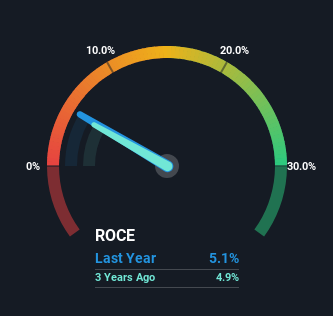Some Investors May Be Worried About Shandong Yisheng Livestock & Poultry Breeding's (SZSE:002458) Returns On Capital

If you're not sure where to start when looking for the next multi-bagger, there are a few key trends you should keep an eye out for. Typically, we'll want to notice a trend of growing return on capital employed (ROCE) and alongside that, an expanding base of capital employed. Ultimately, this demonstrates that it's a business that is reinvesting profits at increasing rates of return. In light of that, when we looked at Shandong Yisheng Livestock & Poultry Breeding (SZSE:002458) and its ROCE trend, we weren't exactly thrilled.
What Is Return On Capital Employed (ROCE)?
For those who don't know, ROCE is a measure of a company's yearly pre-tax profit (its return), relative to the capital employed in the business. Analysts use this formula to calculate it for Shandong Yisheng Livestock & Poultry Breeding:
Return on Capital Employed = Earnings Before Interest and Tax (EBIT) ÷ (Total Assets - Current Liabilities)
0.051 = CN¥246m ÷ (CN¥7.2b - CN¥2.4b) (Based on the trailing twelve months to September 2024).
Therefore, Shandong Yisheng Livestock & Poultry Breeding has an ROCE of 5.1%. In absolute terms, that's a low return and it also under-performs the Food industry average of 6.8%.
See our latest analysis for Shandong Yisheng Livestock & Poultry Breeding

Above you can see how the current ROCE for Shandong Yisheng Livestock & Poultry Breeding compares to its prior returns on capital, but there's only so much you can tell from the past. If you're interested, you can view the analysts predictions in our free analyst report for Shandong Yisheng Livestock & Poultry Breeding .
The Trend Of ROCE
We weren't thrilled with the trend because Shandong Yisheng Livestock & Poultry Breeding's ROCE has reduced by 91% over the last five years, while the business employed 64% more capital. However, some of the increase in capital employed could be attributed to the recent capital raising that's been completed prior to their latest reporting period, so keep that in mind when looking at the ROCE decrease. Shandong Yisheng Livestock & Poultry Breeding probably hasn't received a full year of earnings yet from the new funds it raised, so these figures should be taken with a grain of salt.
While on the subject, we noticed that the ratio of current liabilities to total assets has risen to 33%, which has impacted the ROCE. Without this increase, it's likely that ROCE would be even lower than 5.1%. Keep an eye on this ratio, because the business could encounter some new risks if this metric gets too high.
The Bottom Line
We're a bit apprehensive about Shandong Yisheng Livestock & Poultry Breeding because despite more capital being deployed in the business, returns on that capital and sales have both fallen. Long term shareholders who've owned the stock over the last five years have experienced a 35% depreciation in their investment, so it appears the market might not like these trends either. That being the case, unless the underlying trends revert to a more positive trajectory, we'd consider looking elsewhere.
On a final note, we found 2 warning signs for Shandong Yisheng Livestock & Poultry Breeding (1 is concerning) you should be aware of.
If you want to search for solid companies with great earnings, check out this free list of companies with good balance sheets and impressive returns on equity.
New: Manage All Your Stock Portfolios in One Place
We've created the ultimate portfolio companion for stock investors, and it's free.
• Connect an unlimited number of Portfolios and see your total in one currency
• Be alerted to new Warning Signs or Risks via email or mobile
• Track the Fair Value of your stocks
Have feedback on this article? Concerned about the content? Get in touch with us directly. Alternatively, email editorial-team (at) simplywallst.com.
This article by Simply Wall St is general in nature. We provide commentary based on historical data and analyst forecasts only using an unbiased methodology and our articles are not intended to be financial advice. It does not constitute a recommendation to buy or sell any stock, and does not take account of your objectives, or your financial situation. We aim to bring you long-term focused analysis driven by fundamental data. Note that our analysis may not factor in the latest price-sensitive company announcements or qualitative material. Simply Wall St has no position in any stocks mentioned.
About SZSE:002458
Shandong Yisheng Livestock & Poultry Breeding
Shandong Yisheng Livestock & Poultry Breeding Co., Ltd.
Very undervalued with proven track record.
Market Insights
Community Narratives




